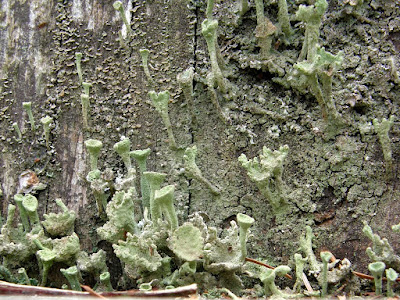We took our regular route past the school a block away, and entered the pedestrian access to the next block. We've been down that path dozens of times. And then we noticed the wooden fence; from one end of the walk to the other, it was overgrown with mixed lichens. And we'd been blind.
Unfortunately, the city government has prudently installed a chain-link fence a few inches in front of the wooden one; no telling when those irresponsible homeowners would have torn down their fence and invited the schoolkids to trample their garden. And then what would define the passageway? Better safe than sorry.
So we had to jam the camera lens through the links in the fence and lean on it to keep it from bouncing.
Mealy pixie cup, with a leaf lichen. Note the brown soredia at the edges of some cups. The glossy black underside of the "leaves" can be seen in spots.
I've given up, for now, trying to identify individual lichens. About all I can manage is to sort them into types; at least that helps me to see them more clearly.
Lichens come in many shapes and colours. By shape, they can be classified (more or less) as:
- Dust lichens. What that sounds like. A dust on the rock or wood.
- Crust lichens. (Crustose, in the formal descriptions.) Pasted on, like thick, dried paint. Or caked mud. e.g., from our area; Bark Barnacle, Bulls-eye. (I love lichen names!)
- Scale lichens. (Squamulose.) Tiny, round flattened shapes. Bottom side is cottony. e..g., Cladonia scales.
- Leaf lichens. (Foliose.) Small to large leaf-shaped lobes, non-cottony underside. e.g.; Punctured Rocktripe, Lettuce Lung.
- Club lichens. Upright stems. e.g.; British soldiers, Waterworm.
- Shrub lichens. (Fruticose.) Lots of branches, in tufts. Reindeer lichen, for example.
- And Hair lichens. Hairy. e.g.; Methuselah's Beard, Speckled Horsehair.
Club-like Cladonia species. Look closely; some have the bright red tip that probably identifies them as Lipstick Cladonia. A few Pixie Cups are intermingled, some growing out of a base of a crust lichen.
One of the frustrating things about lichen is that their shape may change as they grow. Some start as scales or leaves, then later develop the clubs and cups that turn up in the guide books.
Things to look for;
- Apothecia, the fruiting bodies. Little saucers or cups. These will bear little balls or warts, which can be washed off, to sprout in another location. Where are they placed? What shape are they?
- Podetia, the club-like stems. Smooth or warty? Branched or straight?
- Soredia, the little "fruits" or balls, sometimes pin-head sized, sometimes quite large. Or cephalopodia; warty. They come in a variety of colours; red, brown, black, orange ... Do they come off easily?
- "Leaves". Really, lobes of the thallus, or body; not individual sections. Colour? Shape? How are they attached?
- Location. On rock, wood, trees, soil?
Scale Cladonia, I think. Tiny leaf-like thalli, curled upwards at the edges, showing the whitish underside. Below is a larger leaf lichen.
Very neat little Pixie Cups, growing out of a crust lichen base. Some of the cups, though are ragged, something like an anemone in a stiff current. Could be older clubs.
Growing up the wall. Blue-green leaf lichen at the bottom, then Cladonia.
I don't know whether that black crust is a lichen, a slime mold, or a fungus.
Decayed fence post, with lichen "garden". A bit of everything, including some pale brown variants.
And I didn't touch the lichen, nor smell them, which I had promised myself to do. That would have helped in recognition, eventually. My excuse? It was starting to rain again. I'll go back another day and finish the job properly.
Dave Ingram has a couple of posts on lichen of this corner of BC: Taking a Lichen to Lilac, (groan!) and A Pleasing Peltigera. No Cladonia, though.








The wall outside our huse is covered in lichen - it needs painting, but I refuse because I like the lichen so much
ReplyDeleteWe also have an interesting orange lichen on the sea cliffs . it marks the point where the sea spray rises to on a regular basis - beneath it the rocks are bare because there is too much salt, above the orange line the grass begins to grow. In sheltered bays the orange lichen is perhaps twenty feet above the sea level- on exposed cliffs that take the full force of the Atlantic swell it can be 150 feet up
Mark, I'd love to see that!
ReplyDeleteAbout your house wall; you can always claim that the lichen serves as your pollution monitor.
Yes, those lichens are too hard to identify further than their type! I think they are fascinating ... like little cities growing on stumps.
ReplyDeleteThat Dave Ingram's site looks quite interesting ... I'll have to mark that one!
Nice photos and interesting information. I love lichens but they are so hard to identify. Thanks for sharing some of what you know.
ReplyDeleteHello S.
ReplyDeleteThanks so much for the link to my lichen posts, I'll throw a couple back your way. Nice photographs and a great read.
I'm thinking from your last sentence, though, that you're laying down the cladonia gauntlet :) Hmmmm... I do have a couple of alder branches that are loaded with lichen and that I've been meaning to photograph ... but no cladonia on those either.
Cheers,
Dave
Hmmm ... A cladonia gauntlet. Now that you mention it, I'd love to see what turns up over there; the same as ours, or slightly different?
ReplyDelete